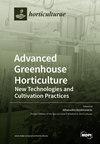Effect of Transplanting Time and Nitrogen–Potassium Ratio on Yield, Growth, and Quality of Cauliflower Landrace Gigante di Napoli in Southern Italy
IF 3.1
3区 农林科学
Q1 HORTICULTURE
引用次数: 0
Abstract
Research has been increasingly focusing on the preservation of the biodiversity of vegetable crops under sustainable farming management. An experiment was carried out in southern Italy on Brassica oleracea L. var. botrytis, landrace Gigante di Napoli, to assess the effects of two transplanting times (9 September and 7 October), in factorial combination with five nitrogen–potassium ratios (0.6; 0.8; 1.0; 1.2; and 1.4) on plant growth, yield, and quality of cauliflower heads. A split-plot design was used for the treatment distribution in the field, with three replications. The earlier transplant and the 1.2 N:K ratio led to the highest yield, mean weight, and firmness of cauliflower heads which were not significantly affected by both transplanting time and N:K ratio in terms of colour components. The 1.2 N:K ratio led to the highest head diameter with the earlier transplant, whereas the 1.0 ratio was the most effective on this parameter in the later crop cycle. The highest nitrate, nitrogen, and potassium concentrations in the heads were recorded with the earlier transplanting time. Antioxidant activity, ascorbic acid, and polyphenol content increased with the rise of the N:K ratio. The element use efficiency was constantly negative with the N:K increase for nitrogen and was augmented until the 1.2 ratio for potassium. The results of our investigation showed that the optimal combination between transplanting time and N:K ratio is a key aspect to improve head yield and quality of the cauliflower landrace Gigante di Napoli, under the perspective of biodiversity safeguarding and valorisation.移栽时间和氮钾比例对意大利南部花椰菜陆地品系 Gigante di Napoli 的产量、生长和质量的影响
研究越来越关注在可持续农业管理下保护蔬菜作物的生物多样性。在意大利南部进行了一项关于甘蓝型油菜(Brassica oleracea L. var. botrytis)的实验,以评估两种移栽时间(9 月 9 日和 10 月 7 日)、五种氮钾比(0.6、0.8、1.0、1.2 和 1.4)的因子组合对花椰菜的生长、产量和质量的影响。田间处理采用分小区设计,共设三个重复。较早移栽和 1.2 的氮磷钾比例使花椰菜头的产量、平均重量和坚实度最高,移栽时间和氮磷钾比例对花椰菜头的颜色成分没有显著影响。氮钾比为 1.2 时,较早移栽的花椰菜头部直径最大,而氮钾比为 1.0 时,较晚移栽的花椰菜头部直径最大。移栽时间越早,头中硝酸盐、氮和钾的浓度越高。抗氧化活性、抗坏血酸和多酚含量随着氮钾比的增加而增加。氮元素的利用效率随着氮钾比的增加一直呈负值,而钾元素的利用效率在氮钾比为 1.2 之前一直呈上升趋势。我们的研究结果表明,从保护生物多样性和提高其价值的角度来看,移栽时间与氮:钾比例之间的最佳组合是提高花椰菜陆地品种 Gigante di Napoli 头部产量和质量的关键因素。
本文章由计算机程序翻译,如有差异,请以英文原文为准。
求助全文
约1分钟内获得全文
求助全文

 求助内容:
求助内容: 应助结果提醒方式:
应助结果提醒方式:


